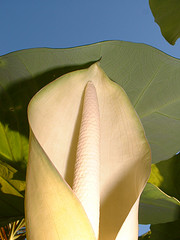
I am currently based in New Zealand and have access to Taro in a few varieties , via the Pacific Island communities, one of which is the wild version, which has notably black stems. This is not true of Madumbi, which also has a flower very similar to the Arum. I would be very keen to grow the South African variety as it is a very different flavour to the common Pacific Taro which as previously noted is very bland. Here is a link to a picture of the flower …
I did some more Googling, and found out a bit more about the project and its originater; depending on the story that’s either “Dr James Hartzell, a self-proclaimed ‘white boy from New York’,” or Professor Thembinkosi Modi, of the University of KwaZulu-Natal’s School of Agricultural Sciences. (Modi won a TWAS (Third World Academy of Science) Young Scientist Award in 2007.) Whatever, the end result was an organic cooperative of growers sending the amadumbe (or amadumbi) to a supermarket chain. Everything seemed rosy, with farmers reporting higher incomes that they were using to improve their lives, buying better houses, medical care, and education for their children. Except that there seems to have been a worm in the amadumbe: free-riders. Who were they?
Members who were male, poorly educated, partially certified, aware of loopholes in the grading system, and who did not trust the buyer.
The authors of the paper quoted above make specific recommendations to deal with the problem, but I cannot discover whether anything came of them. I’m also no aroid taxonomist, and frankly I’m not sure how informative the flower photo is, ((Downloaded from flickr.)) but there you have it. Now, maybe other people can chime in with more information.